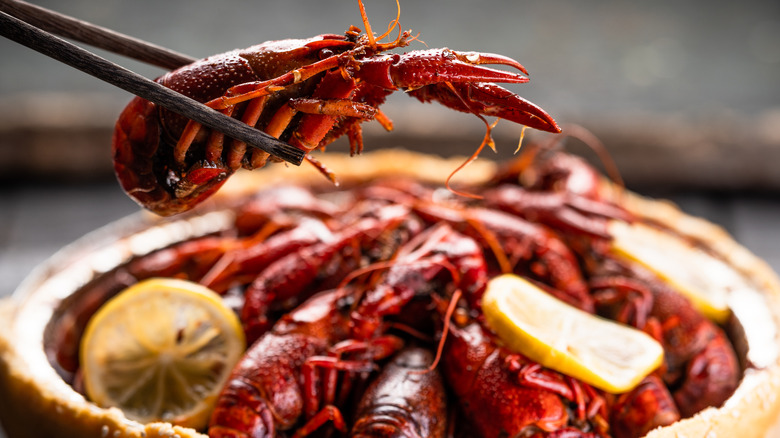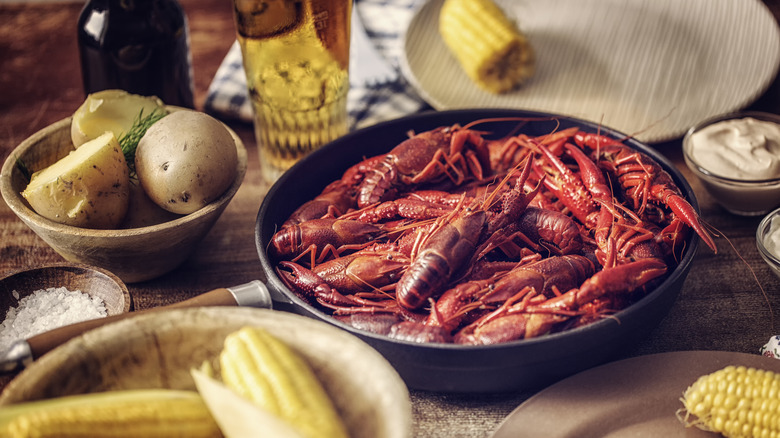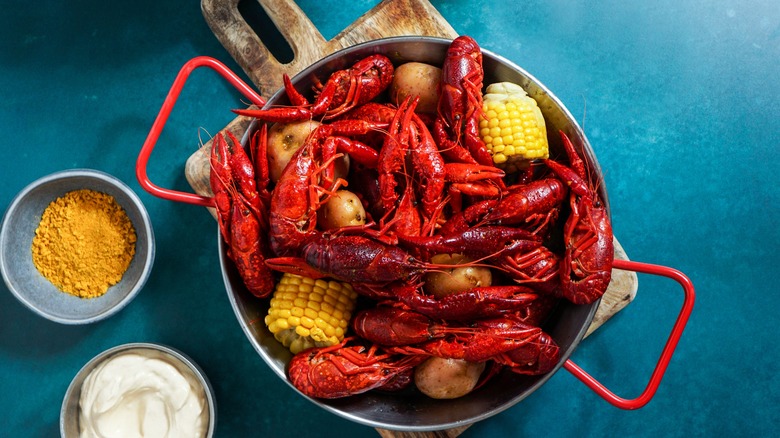How Crawfish Became An Integral Part Of Mardi Gras Celebrations
Mardi Gras — a festival celebrated by Southern U.S. states and Lousiana in particular — is known for its colorful beads, parades, and a motto of "Let the good times roll." More importantly, the festival season is known for its abundance of seafood, with crawfish being the star of the show. A crustacean similar to shrimp, crawfish resembles tiny lobsters and has become a Mardi Gras tradition for many. The crustacean is served in a gumbo-style dish called crawfish étouffée, which features the seafood combined with peppers, onions, and rice. Many locals and visitors alike also boil crawfish in a large pot with various spices and veggies.
The state of Louisiana, the heart of Mardi Gras for many, even has an annual crowning of the Crawfish Queen. The chosen winner attends an annual Mardi Gras ball in Washington D.C., where they may have the chance to meet the president. Crawfish, also known as crayfish and mudbugs, has a deep history in Lousiana and the South, but its ties to Mardi Gras are thanks to its Cajun roots in the parish of Acadia.
It became an annual tradition for rural towns in northwest Acadia for Mardi Gras participants to go door to door to gather ingredients for a large, community gumbo. Crawfish were an economic food for many at the time and became an ingredient thrown into these communal pots. The tradition of crawfish étouffée and crawfish as a food meant to be shared has continued to this day.
The history of crawfish in Louisiana
While French settlers may have brought Mardi Gras to the region and adapted to the food, Native Americans first discovered the seafood in the region. Crawfish became the symbol for the Houma Tribe, representing their determination and fearlessness. The Houma Tribe that settled in the region fished for crawfish with deer meat. When Canadian settlers arrived in the 1700s, they discovered the swamp lands bountiful with crawfish. However, they refused to eat the seafood that came from mud — hence the nickname mudbugs.
Crawfish soon became a source of food for poor families in the region, and its reputation grew from there. The Cajun recipes of the modern day began to form during the 1800s when Acadians applied their culinary knowledge of lobsters to crawfish. In particular, religion played a part in the popularity of crawfish in the region. Southern Catholics began to eat crawfish during the Catholic practice of Lent, which restricts eating meat. The late 1800s saw the rise of crawfish festivals throughout the region. Likewise, Louisiana officially recognized Fat Tuesday and Mardi Gras as a state holiday during this same period. Crawfish and Mardi Gras have been intertwined ever since, and the fish's popularity spread to other states.
The season played a role
One of the big reasons that crawfish became popular during Mardi Gras is because the festival overlaps with crawfish season. On a good year, crawfish is harvested between November and July. However, the peak season and when most people will find crawfish in ready supply is between February to May. Likewise, Mardi Gras typically begins in January and reaches a fever peak in the first two weeks of February.
The ample supply of the crustacean likely helped in making it a staple during festival season. According to Louisiana Wildlife & Fisheries, fishermen and farmers harvest between 100 to 120 million pounds of crawfish per year. The state produces more crawfish than any other state in the country. Crawfish boils began in earnest in Louisiana in the 1900s. Modern technology such as propane burners has made crawfish boils more accessible for many, as well.
By the 1980s, Louisiana began shipping live crawfish across the country garnering new fans for the crustacean. Likewise, over the years, Mardi Gras has spilled out into Alabama (the first Mardi Gras celebration in America actually took place in Mobile), Mississippi, Texas, and even Florida. Come Mardi Gras season, many invite family and friends to crawfish boils where they also enjoy King cake for dessert.


